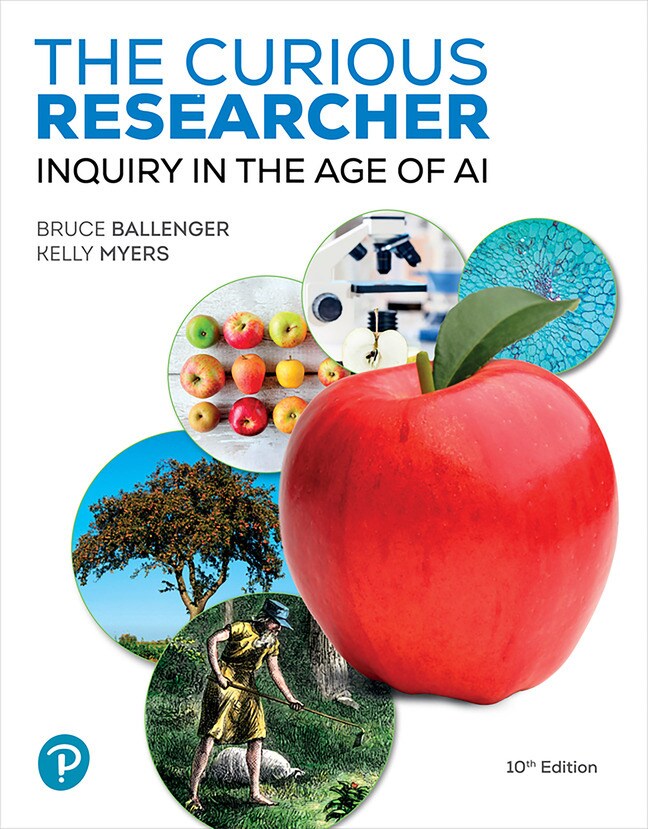
The Curious Researcher: Inquiry in the Age of AI, 10th edition
- Bruce Ballenger
- , Kelly Myers

- Find it fast
Quickly navigate your eTextbook with search
- Stay organized
Access all your eTextbooks in one place
- Easily continue access
Keep learning with auto-renew
The Curious Researcher: Inquiry in the Age of AI provides an inquiry-based guide to writing research papers that shows how to harness the power of AI. This appealing alternative to traditional research texts stands apart due to its conviction that research writing can be full of rewarding discoveries. Throughout the text, Bruce Ballenger and new co-author Kelly Myers stress that curiosity is the best reason for investigating ideas.
The 10th Edition has been thoroughly revised to show how you can leverage generative AI in your research and writing without surrendering authority over your work. In addition, new co-author Dr. Kelly Myers brings new perspectives that strengthen the text, including a deep understanding of the first-year student experience, a grounding in rhetoric and a keen understanding of argument.
Published by Pearson (June 26th 2024) - Copyright © 2025
ISBN-13: 9780138311353
Subject: Composition
Category: Research
- Thinking about, and Rethinking, Researched Writing
- 0.1 Generative AI as a Writing Assistant
- 0.2 Using This Book
- 0.3 Pen to Paper: Fastwriting and Notebooks
- 0.4 Patience: The 5-Week Plan
- 0.5 Process: Unpacking Your Assignment
- 0.6 Facts Don’t Kill
- 0.7 Creative Research Papers?
- 0.8 Following the Furrows
- The First Week
- 1.1 Generative AI and Research: The Crew Not the Captain
- 1.2 The Importance of Getting Curious
- 1.3 Developing a Working Knowledge
- 1.4 Narrowing the Subject
- 1.5 “Why I Write?”
- 1.6 Reading for Research: A Metaphor
- 1.7 Following the Furrows
- The Second Week
- 2.1 What Are Your Research Routines?
- 2.2 Planning for the Dive
- 2.3 An AI-assisted Literature Review
- 2.4 Developing Focused Knowledge
- 2.5 Keeping Track of What You Find: Building a Bibliography
- 2.6 The College Library and the Defense of Access
- 2.7 Searching Library Databases for Books and Articles
- 2.8 Advanced Internet Research Using Google Scholar
- 2.9 Searching Library Sources
- 2.10 Living Sources: Interviews and Surveys
- 2.11 Fieldwork: Research on What You See and Hear
- 2.12 Following the Furrows
- The Third Week
- 3.1 Writing in the Middle: Conversing with Sources
- 3.2 Notetaking as a Scene of Writing
- 3.3 Dialogues with Generative AI
- 3.4 Working with Sources: A Shifting Relationship
- 3.5 Plagiarism Q & A
- 3.6 Why Plagiarism Matters
- 3.7 The Notetaker’s Triad: Quotation, Paraphrase and Summary
- 3.8 Notetaking Methods
- 3.9 When You’re Coming Up Short: More Advanced Searching Techniques
- 3.10 Following the Furrows
- The Fourth Week
- 4.1 Your Thinking, Your Draft
- 4.2 Getting to the Draft
- 4.3 Organizing the Draft
- 4.4 Preparing to Write the Draft
- 4.5 Starting to Write the Draft: Beginning at the Beginning
- 4.6 Writing for Reader Interest
- 4.7 Writing with Sources
- 4.8 Driving through the First Draft
- 4.9 Following the Furrows
- The Fifth Week
- 5.1 Generative AI Couldn’t Write This
- 5.2 Strategies for Global Revision
- 5.3 Using Generative AI to Evaluate the Draft
- 5.4 Using Generative AI to Re-research
- 5.5 Local Revision: Revising for Language and Voice
- 5.6 Using Generative AI to Evaluate Style and Persona
- 5.7 Preparing the Final Manuscript
- 5.8 Following the Furrows
Appendix A: Communicating Your Research
- A1 Life Beyond the Research Paper
- A2 Genre-Fit: Finding the Best Match for Your Rhetorical Goals
- A3 Learning a New Technology
- A4 Quick Guide to Multimedia Genres
- A5 Following the Furrows
Appendix B: Guide to the New MLA Style
- B1 Citing Sources in Your Work
- B2 Building Citations for the Work Cited Page
- B3 Preparing the Works Cited Page and Other Formatting
- B4 Student Paper in MLA Style
Appendix C: Guide to APA Style
- C1 Citing Sources in Your Essay
- C2 Formatting Your Essay
- C3 Preparing the References List
- C4 Student Paper in APA Style